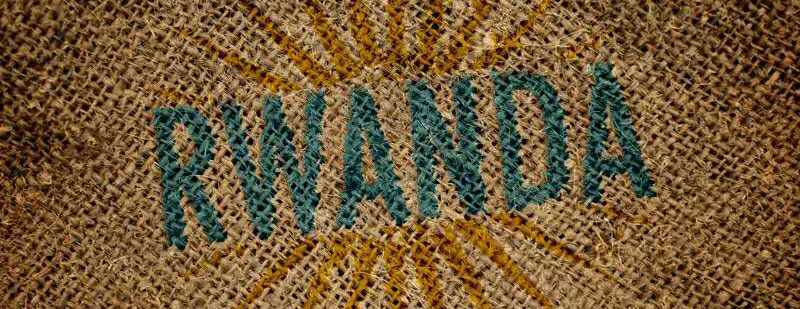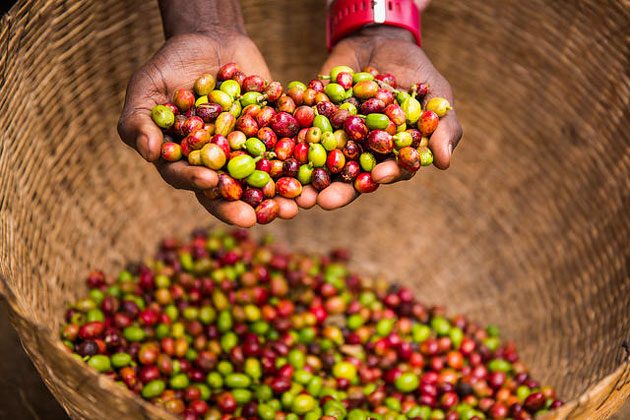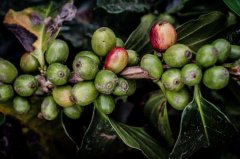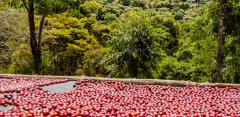Rwanda coffee beans introduction bourbon gene mutation coffee beans history story flavor taste characteristics description
Rwandan coffee plays an important role in the country's economy, making a significant contribution to foreign exchange earnings and the monetization of the rural economy.
About 95% of coffee plants in Rwanda are high-quality Arabica varieties of bourbon coffee. A relatively small number of Catuai and Caturra varieties were also planted. The varieties of coffee beans grown in Rwanda include Caturra, Catuai, Bourbon (Arabica) and Harrar, etc.; POP3303/21;jackson 2, 1257 and BM 139; BM 71. Coffee beans like bourbon have been growing in the wild in Rwanda for more than a century. Bourbon beans are famous for their rich creamy chocolate, sweetness and very light fruit flavor. They produce balanced coffee and are rarer than other types of coffee beans because bourbon plants usually carry fewer coffee cherries per plant than other varieties.

POP3303/21: high yield, tolerance to drought, coffee leaf rust and coffee berry disease. Adapt to a wide range of ecosystems. Found mainly in Rwanda. The color of the higher leaf tip of the coffee tree is bronze. Beans are of medium size.
Bloodline
The selected Rwanda BMJ (Blue Mountain Coffee Jamaica) is related to but different from Typica.
Information genetic description
Bourbon-Typica Group (Typica-related)
History
This population was selected from a survey of trees in the M. N é mery plantation in Cyangugu (formerly Shangugu, a city in western Rwanda) in 1972. The plantation is said to grow the Blue Mountain variety, which is locally known as BMJ in Rwanda. BMJ was introduced to East Africa from Jamaica via Nyasaland (now Malawi) in 1894 and spread from there to East Africa. During the introduction of BMJ, the only known variety grown in Jamaica was Typica. Therefore, people believe that BMJ-- and therefore Pop3303/21-- are related to iron pickups. In 2003, the Rwanda Agricultural Commission announced that Pop3303/21 would be produced commercially in Rwanda.
Usability
Information breeder
Rwanda Agricultural Committee (RAB)

Jackson 2/1257
Bloodline
Select Jackson. A genetic background similar to bourbon.
Information genetic description
Bourbon-Typica Group (Bourbon-related)
History
Mr. Jackson, a coffee farmer in Mysore, India, in the early 1900s, found trees on his farm that were tolerant to coffee leaf rust (this tolerance has been lost, and the variety is thought to be vulnerable to rust). In the 1920s, the seedlings of these trees were sent to research stations in Kenya and Tanzania. These primitive trees produced the Jackson species that are now common in Rwanda. (the account of how Jackson arrived in Rwanda from Kenya is not well referenced; documents suggest that it may have come from a germplasm collection in Mulengu, Democratic Republic of the Congo in the 1930s, or brought by Kenyan settled farmers in the 1940s. )
The varieties known as Jackson, Kent, Coorg and Mysore all come from the same region of India and are likely to be the late descendants of the first coffee seeds Babudan brought to India from Yemen in 1670. Recent genetic tests have confirmed that Jackson is linked to the bourbon genome.
Usability
Information breeder
Rwanda Agricultural Committee (RAB)
Bourbon Mayaguez 139 is a high variety with exuberant growth and high yield, and has very good cup quality. It is common in Rwanda and Burundi.
Bloodline
A genetic background similar to bourbon.
Information genetic description
Bourbon-Typica Group (Bourbon-related)
History
Bourbon Mayaguez 139 gets its name because it is thought to have been collected from Central America through the Mayaguez germplasm of the United States Department of Agriculture in Puerto Rico. Bourbon was previously introduced to Puerto Rico from Central America. It was introduced into the Mulengu germplasm collection in the Democratic Republic of the Congo in the 1930s and brought to Rwanda in the early 1950s. It is an important breed of Rwanda.
When the population of Bourbon Mayaguez was introduced to East Africa, some mother trees were selected as the basis for the release of new varieties. Bourbon Mayaguez 71 and Bourbon Mayaguez 139 are derived from these selections; they are very similar in agronomic performance.
Usability
Information breeder
Rwanda Agricultural Committee (RAB)
Bourbon Mayaguez 71
Moderate output, good cup potential, easy to suffer from major diseases. Suitable for medium height. It is common in Rwanda and Burundi.
Bloodline
A genetic background similar to bourbon.
Information genetic description
Bourbon-Typica Group (Bourbon-related)
History
Bourbon Mayaguez 71 gets its name because it is thought to have been collected from Central America through the Mayaguez germplasm of the United States Department of Agriculture in Puerto Rico. Bourbon was previously introduced to Puerto Rico from Central America. It was introduced into the Mulengu germplasm collection in the Democratic Republic of the Congo in the 1930s and then in Rwanda in the early 1950s. It is an important breed of Rwanda.
When the population of Bourbon Mayaguez was introduced to East Africa, some mother trees were selected as the basis for the release of new varieties. Bourbon Mayaguez 71 and Bourbon Mayaguez 139 are derived from these selections; they are very similar in agronomic performance.
Usability
Information breeder
Rwanda Agricultural Committee (RAB)
Bourbon Mayaguez 71
Important Notice :
前街咖啡 FrontStreet Coffee has moved to new addredd:
FrontStreet Coffee Address: 315,Donghua East Road,GuangZhou
Tel:020 38364473
- Prev

Introduction of Fairtrade Fine Coffee Bean Flavor growth characteristics in five Coffee producing areas of Rwanda
Overall, coffee from Rwanda is more rated than coffee from neighboring Zimbabwe and Zambia, but it has not yet been recognized by coffee from Kenya and Tanzania. Rwanda also produces Fairtrade coffee beans. There are several high-altitude Rwanda from Rwanda on the front street, which is suitable for growing boutique coffee. The main coffee-growing areas have volcanic soil rich in nitrogen. Major coffee growing areas
- Next

Processing method of coffee beans in Rwanda Coffee washing station hand-classified coffee cherry processing steps
Throughout Rwanda, coffee beans are usually processed by wet processing. This is largely due to the efforts of modern people to invest time, energy and resources to develop public cleaning stations for the countless traces of coffee and cherries that need to be processed each year. Many of the small farms involved in the business are unable to create large independent washing stations like large coffee farms around the world. This is because most farmers
Related
- Detailed explanation of Jadeite planting Land in Panamanian Jadeite Manor introduction to the grading system of Jadeite competitive bidding, Red bid, Green bid and Rose Summer
- Story of Coffee planting in Brenka region of Costa Rica Stonehenge Manor anaerobic heavy honey treatment of flavor mouth
- What's on the barrel of Blue Mountain Coffee beans?
- Can American coffee also pull flowers? How to use hot American style to pull out a good-looking pattern?
- Can you make a cold extract with coffee beans? What is the right proportion for cold-extracted coffee formula?
- Indonesian PWN Gold Mandrine Coffee Origin Features Flavor How to Chong? Mandolin coffee is American.
- A brief introduction to the flavor characteristics of Brazilian yellow bourbon coffee beans
- What is the effect of different water quality on the flavor of cold-extracted coffee? What kind of water is best for brewing coffee?
- Why do you think of Rose Summer whenever you mention Panamanian coffee?
- Introduction to the characteristics of authentic blue mountain coffee bean producing areas? What is the CIB Coffee Authority in Jamaica?

